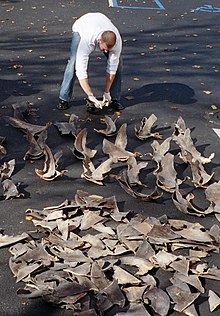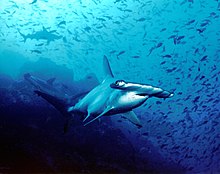Shark fin trading in Costa Rica

Shark fin trading in Costa Rica, or
However, there is environmental awareness of the consequences of fin trade exploitation which could result in shark extinction. Prompted by WildAid’s campaigns, in East Asia, high profile politicians and their kin, film personalities, industrial establishments and committed individuals took voluntary “No shark fin” pledge. In January 2011, British chef Gordon Ramsay spoke of how he and his TV crew were held at gunpoint and soaked with petrol when filming a documentary about the illegal trade in Costa Rica.[4]
Practice
In response to poor incomes and pressure, local fisherman are forced into harvesting shark fins, despite only getting about one dollar per pound on an average, less than a third of its total retail value.[5] Corrupt politicians are silenced with a fee to ignore government regulations.[6] The practice involves sharks being caught by a horizontal drag line with many baited hooks, known as longline fishing. According to biologist Jorge Ballestero of the Costa Rican Sea Turtle Restoration Project (Pretoma), “Costa Rica has become intricately linked to this trade for two reasons: It has the biggest longliner fleet in the hemisphere, and it allows international vessels dedicated to the exploitation and trade of shark fins to land here.”[3]
The Taiwanese mafia dominate the shark finning industry in Costa Rica, although Indonesian gangs also have a foothold in the market.[3] The Taiwanese and Indonesian mafia operate private docks in the Puntarenas area, notably Inversiones Cruz Dock and Harezan Dock and several others where some 95% of all catches are brought in, transported by truck to San José and flown mostly to Hong Kong.[3] According to the Costa Rican customs adviser Omar Jiminez, at least three boats full of shark fins enter the ports in Puntarenas every week.[7] Kaohsiung in Taiwan is one of the biggest ports in the world for importing shark fins. They are brought in from overseas and are placed out to dry in the sun on residential rooftops near the port.
However, various shark cartilage industries in the country exist, depending on the import of cartilages from other countries.[8][9] Costa Rica is mentioned as one such country where a leading processing plant is said to be purchasing raw cartilages from any source in the world to carry out semi or primary processing before exporting it, particularly to the USA.[9] The USA then markets it worldwide in the processed shark cartilage powder form, under four or five brand names.[9]
History
In the 1970s, mass local and reef fishing off the
In 1982, the National Learning Institute of Costa Rica received technical support and financing from the Taiwanese government to modernize its fishing fleet according to Pretoma.[3] This had a major impact on the finning industry in Costa Rica, which subsequently took off in the 1980s (especially after 1986[8]). Due to low shark populations on the coasts, the updated vessels could now venture further out to sea and use longline technology to greatly increase their catches. Meeting the increasing demand in the Tiger economies of the Pacific Rim countries for shark fins brought about their economic growth and increased wealth in the 1980s and 1990s. By the late 1990s, Costa Rica had become established as a major cargo-unloading point for international fleets and thus became a key component in the global finning industry.[3]
In May 2003, a young Costa Rican Coast Guard official, Manuel Silva, reported the landing of a Taiwanese fishing vessel with 30 tons of shark fins on board. Not only were the Taiwanese vessels ignored by the four agencies charged with checking incoming cargos but the Costa Rican Fishing Institute (Incopesca) also failed to take action following his report.[3]
In 2006/2007, Canadian director
Today, Costa Rica is one of the world's most important participants in the shark-fin trade. Shark finning in Costa Rica was made illegal in 2012, signed into law by President Chinchilla. There is still a viable illegal market present.[3]
Demand
In
In the South Asian region, use of shark cartilage in preparing soups is considered a health tonic. Hong Kong imports it from North and South American countries, particularly for use in either a cooked format or to prepare boiled soup, as a health fad, by mixing it with herbal supplements.[18]
Another large demand for shark cartilage is for manufacture of "Shark Cartilage Powder" or pills as a cure for cancer. The anti cancer claims of such powders marketed in many parts of the world has been discounted by the US Food and Drug Administration and Federal Trade Commissions. In spite of such injunctions, the trade in this powder continues and the shark cartilage powder is still widely marketed as a cancer cure, stated to be selling at US$145 per gram.[19] It is also stated that in Costa Rica, one single firm alone processed 235,000 sharks every month to manufacture cartilage pills.[19]
Environmental concerns

Since the late 1980s populations of northwest Atlantic coastal and oceanic shark have dropped by an average of 70%, and in 2003 the
As far back as 1999, FAO initiated action to introduce a “Voluntary Plan of Action for sharks.” The response, though not spontaneous, received support from 15 countries including Costa Rica. Even in the early 2000s, the fin trade market's influence on over exploitation of fins was realized, with many countries imposing ban on fishing of these species. Goaded by WildAid's campaigns in East Asia, high-profile politicians and their kin, film personalities, industrial establishments and committed individuals took voluntary “No shark fin” pledge and many personalities hosted banquets with “shark free” announcements. There is now constant publicity in the media in this regard in eastern Asia.[21]
Crackdown
Former Costa Rican president
References
- ^ "Shark Fin Soup". Thailand Life. 3 January 2011.
- ^ Boddiger, David. "Shark Fin Mystery Deepens" (PDF). Pretoma. Retrieved 4 January 2011.
- ^ a b c d e f g h i j k l m n o p q r Boddiger, David. "Sharks pay price and fin trade prospers" (PDF). Pretoma. Retrieved 3 January 2010.
- ^ "Gordon Ramsay threatened at gunpoint during illegal fishing investigation".
- ^ Stewart, Rob (2006), Sharkwater
- ^ "A Sunday at Sea with Sea Shepherd and the Shark Killers". Sea Shepherd Conservation Society. 6 August 2007. Retrieved 4 January 2011.
- ^ Institute for Central American Studies (1 January 2004). Mesoamerica. Institute for Central American Studies. Retrieved 3 January 2011.
- ^ ISBN 978-2-8317-0650-4. Retrieved 3 January 2011.
- ^ ISBN 978-1-85850-114-7. Retrieved 4 January 2011.
- ^ "Interview with Rob Stewart on his film Sharkwater about the shark problem in Costa Rica". George Stroumboulopoulos Tonight. 26 January 2009.
- ^ a b "Yao Ming unlikely to curb China's shark fin appetite". Taipei Times. 3 May 2006. Retrieved 3 January 2011.
- ^ "Media silent on shark fin soup affair". The Standard. 1 September 2006. Archived from the original on 2 November 2007. Retrieved 3 January 2011.
- ^ Bradsher, Keith (17 June 2005). "Disneyland in China Offers a Soup and Lands in a Stew". The New York Times. Retrieved 3 January 2011.
- ^ Bakalar, Nicholas (12 October 2006). "38 Million Sharks Killed for Fins Annually, Experts Estimate". National Geographic. Archived from the original on November 5, 2006. Retrieved 3 January 2011.
- ^ "Alternative approaches to prostate cancer treatment". Prostate Cancer Treatment. Archived from the original on 2 June 2008. Retrieved 3 January 2011.
- ^ Pollack, Andrew (3 June 2007). "Shark Cartilage, Not a Cancer Therapy". New York Times. Retrieved 3 January 2011.
- ^ Chao, Julie (19 May 2004). "Chinese Taste For Endangered Seafood Growing". Cox News Service. Archived from the original on 19 December 2008. Retrieved 3 January 2011.
- ^ ISBN 978-92-5-104361-5. Retrieved 3 January 2011.
- ^ ISBN 978-1-4051-2494-2. Retrieved 4 January 2011.
- ISBN 978-0-8108-2215-3. Retrieved 4 January 2011.
- ISBN 978-1-59056-003-7. Retrieved 4 January 2011.
- ^ Institute for Central American Studies (Costa Rica) (2007). Mesoamerica. Institute for Central American Studies. p. 25. Retrieved 4 January 2011.


